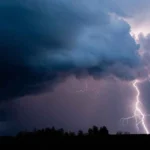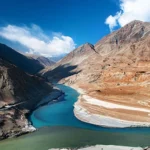
Rain or different kinds of precipitation that contain raised hydrogen particle levels, making it acidic, are alluded to as corrosive downpour. Raised degrees of hydrogen particles cause the downpour to have a low pH, making it harming to oceanic creatures and plants and it can make paint strip and erode steel structures, extensions and stone models. Corrosive downpour creates when sulfur dioxide and nitrogen oxide emanations respond with environmental water particles and produce corrosive. In spite of the fact that the impacts of contamination on structures were noted during the 1600s, the connection between barometrical contamination and the corrosive downpour it produces was first brought to consideration in 1852 in Manchester, England. Governments have been working since the 1970s to lessen these outflows and their endeavors have had extremely sure outcomes.
Acid rain can also be produced from volcanic eruptions, burning coal and even rotting plant life.
Scientists and researchers use the pH scale to measure the acidity of rain. A neutral pH (neither acidic or alkaline) is 7, while normal rain usually has a pH of about 5.6. Acid rain generally has a pH between 4.2 and 4.4. According to the Environmental Protection Agency, Over 250 monitoring sites collect acid rain across the United States, Canada, and the US Virgin Islands.
Acid rain cannot rot your skin. It usually doesn’t taste or smell any different than normal rain.
When the pH levels in rivers, streams, lakes, and soil are lowered due to acid rain, it takes a disastrous toll on the ecosystem. Many fish are not able to survive in an acidic environment, and plants begin to die because the acid dissolves nutrients in the soil. Plants can also soak up some of the toxins in the acid rain, making them unfit for human consumption.
The sulfur dioxide and nitrogen oxide that creates acid rain can cause diseases such as cancer, asthma and even heart disease. It’s a concern in the air, but not in the rain itself.
Acid corrodes stone and rock, which could be dangerous for the livability of a home or building if the foundation becomes corroded. Sculptures, statues, and paint exposed to the elements are also horribly damaged.
The acid in acid rain can damage a car’s paint job, but it won’t melt the car.
Acid Rain Became Well-Known in the 20th CenturyEven though it was first identified back in the 19th century, acid rain became well-known by many during the 1980s. By this point, many understood the link between the prevalence acid rain and the proliferation of unchecked emissions from industry. According to the National Science Foundation, acid rain started in the USA in the 1950s thanks to pollutants from coal plants in the Midwest.
Acid rain can actually kill a forest. The acid rain can kill the leaves on the trees by cutting off their light and nutrient supply. It also changes the acidity in the soil, making it impossible for trees and other plant life to grow. It also poisons the soil and plant life.
Through the 1970 Clean Air Act, United States Congress intended to regulate acid emission. They further strengthened the act in 1990. The legislation seemed to have an effect, as sulfate and nitrate rates in precipitation were cut by 40% by the new millennium, according to the National Science Foundation.
When acid rain lands in the water such as streams, lakes and rivers, it changes the pH and makes the water toxic to the fish and other life in the water.
Federal reports have suggested the Environmental Protection Agency, in particular, is having some trouble reducing the amount of acid rainfall. A 2013 report from the Government Accountability Office said at the time, 88% of the Great Lakes were impaired by acid rain, and that 21,000 miles of streams were tainted in the central Appalachian Mountains.
Entire lakes have been declared dead because of acid rain.
The only real solution to combatting acid rain is by burning fewer fossil fuels and promoting alternative energy, which has had mixed success in recent years. Individuals can use less electricity and drive less to reduce emissions and converse energy as well.
Acid rain has a pH of 4.3 while pure water is perfectly balanced at 7.
Acid rainfall can cause serious repertory problems and greatly impact human health. It has been estimated that around 550 premature deaths each year occur due to acid rain.
Acid rain has the same approximate pH as vinegar and orange juice.
In drier areas, people see acid gas or acid dust in lieu of rain, and even acid snow in colder parts of the world. The toxic acids in the atmosphere can mix with essentially any material, including hail or fog.
Rain is not the only type of precipitation that can be called acid rain. Snow, fog, and even dust can contain the same damaging toxins as acid rain.
In some parts of the world, where the pH of water in lakes or streams is more alkaline, acid rain has less of an effect. Some soils and rocks also contain high levels of calcium and magnesium, which can inhibit or even neutralize acid rain.
Acid rain can be neutralized the same way as acid can be. In some environments acid rain is more problematic. For instance, Eastern Canada lacks a natural alkalinity. Lime is able to neutralize acid, but there is no lime in the ground in some areas and because of this the acid rain is able to do more damage.
Acid rain directly impacts the livelihoods of trees. It damages the protective layers on leaves and disrupts the photosynthesis process by inhibiting the plant’s ability to take in carbon dioxide. Experts have pointed to acid rain as the cause of forest death in many parts of the world.
Sulphur dioxide, which is a major contributor to acid rain, is produced by burning fossil fuels and it is a by-product of many industrial processes.
Robert Angus Smith wrote about the relationship between acid rain and pollution back in the mid-19th century. He also first coined the phrase ‘acid rain’.
A large amount of the acid rain that reaches Canada is the result of emissions in the United States.
Today’s acid rain is primarily fueled by nitrogen emissions mixing with rain. The monitoring of nitrogen emissions has varied by country. Some see the debate about climate change as potentially inhibiting progress in keeping track of emissions.
Nitrogen oxide, a major contributor to acid rain, is produced by the exhaust from vehicles, from furnaces and other equipment. A large amount of Canada’s nitrogen oxide emissions originate in the United States.
With an ever-growing global population, more and more farmers will use nitrogen fertilizer to feed people, thus creating more nitric acid, according to Scientific American. Leaders are discussing the management of nitrogen emissions and monitoring requirements.
Despite major efforts to decrease acid rain, it is still killing lakes and aquatic life. 95,000 lakes in North America have been damaged by acid rain.
Technology is constantly being produced to detect the amounts of pollutants like sulfur dioxide. A camera created by the Universidad Carlos III de Madrid’s Laboratorio del Infarrojo could help this problem. It could work along side an alarm system to signal the leak of specific gases. Some technology has the ability to detect compounds in real time, even if the actual device is hundreds of meters away.









